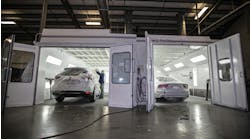The idea of the "connected car" has received significant buzz in the automotive industry, with OEMs and technology vendors touting the benefits of turning a vehicle into a network node that can seamlessly connect drivers' smartphones, iPods, tablets and other devices. In the auto repair space, though, telematics technology (which is intrinsically linked to this connected vehicle functionality) holds the most promise for the industry.
A variety of OEMs, insurers, parts suppliers, fleet services companies and technology startups now offer telematics solutions that can do everything from tracking vehicle location to monitoring driver behavior and accessing diagnostic information, and the availability of these systems continues to expand. According to Frost & Sullivan, OEMs are increasingly making telematics systems a standard feature in vehicles and signing up users for connected service for multiple years at a time, rather than asking for monthly subscription fees. According to ABI Research, the number of telematics users is expected to increase from 72 million to more than 300 million by 2018.
Toyota has one of the most advanced systems, providing a social network of customers, dealers and OEMs to provide service alerts. Hyundai's Bluelink, meanwhile, is free for three years in some vehicles and is tied to roadside assistance and warranty offerings. It also provides in-vehicle service scheduling and an in-vehicle recall advisor.
But apart from the OEMs, insurance companies have been the most aggressive proponents of telematics solutions. Progressive, State Farm, Allstate and others have deployed "usage based insurance" (UBI) products that use telematics hardware to monitor driver behavior and reward "good" drivers with lower premiums. Aftermarket telematics solutions are also emerging, and may present an opportunity for non-dealer repair shops to take advantage of these systems.
Theoretically, a telematics device with access to diagnostic codes and vehicle data (like miles driven) could send alerts to a driver's smartphone indicating that it was time for an oil change or provide trouble code details when the check engine light comes on. If the driver has established a relationship with a repair shop, that information could also be sent to the repairer to prompt a callback, schedule an appointment or even initiate a parts order. Using location-based data, these systems could also point drivers to the location of the nearest repair shop or tow truck service in the event of an accident.
"By taking this data and sharing it with drivers in a more valuable form, they will reward you with more loyalty," says Blair Currie, vice president of marketing at Intelligent Mechatronic Systems (IMS), which offers a telematics solution that combines an OBD-II device and smartphone connectivity.
How all of this would work, however, is still unclear. "What is the business model?" says Chris Slesak, director of telematics at Delphi Automotive. "For fleet management and UBI, it's well known. For the independent aftermarket, it's not known right now."
The insurance approach
For any of this to happen, there has to be an ecosystem of telematics users and services available that can link drivers and repairers. Since the OEMs are primarily operating closed telematics systems, the next most logical place for this ecosystem to develop is in the usage-based insurance market.
According to Frost & Sullivan, 60 percent of major insurance companies in the U.S. offer a mileage or behavior-based discount to customers using telematics technology. "The objective for all of these programs are to decrease cost of ownership for a specific set of customers, as telematics-based insurance is not a one size fits all solution," said Praveen Chandrasekar, telematics and infotainment program manager at Frost & Sullivan. "This particularly will help attract first time younger car buyers, for whom cost of ownership is a big deal."
Progressive has probably the most well-known UBI solution (Snapshot), which according to company spokesperson Erin Vrobel is in place on 1.2 million policies, or used by about one in three drivers eligible for the service. The system (which uses an OBD-II plug-in device) collects information about how, how much and when a customer drives.
"Time and speed information helps to calculate the number of miles a customer drives, when they drive and how often he or she slams on the brakes," Vrobel says. "However, it’s important to note that while the usage-based data is an important part of the rating formula, Progressive still rates primarily on traditional data such as driving history, vehicle type, etc."
State Farm provides services more in line with OEM systems like OnStar: emergency response, roadside assistance, vehicle location assistance, diagnostic and speed alerts, and its In-Drive service can be used with both OnStar and Ford SYNC equipment. Allstate's DRIVEWISE is similar to the Progressive program, focusing on mileage and speed, without the accompanying GPS data.
According to Fred Blumer, founder of Hughes Telematics and CEO of Vehcon, there is an opportunity for repairers to partner with insurance companies on these UBI programs, which will eventually cover millions of vehicles. "Consumers want to be connected everywhere they are in every aspect of their life," Blumer says. "I've had conversations with insurance companies, and they definitely see opportunities to work with the aftermarket on telematics issues."
If there's an opportunity for body shops to tie into UBI technology, it would likely come through DRP programs; in the event of an accident, the telematics solution could potentially issue nearby shop recommendations to drivers via their smartphones or an in-vehicle device (like the OnStar system). For that to work, though, would require location data, crash detection information, and the active participation of the shops, the insurer and the vehicle owner to establish the service in advance. And right now, many UBI systems don't collect location or diagnostic data.
For mechanical repair shops that provide regular maintenance (oil changes, tire rotation, etc.), there is more of a play, since vehicle owners would be interested in getting usage-based alerts about maintenance from their preferred shop. Rather than sending a mailer every three or six months to customers about oil changes, specific customers could be targeted for reminders via e-mail or text message based on their actual mileage, for example.
Shops could also remotely read trouble codes, which could make scheduling repairs easier for both the driver and the shop. But some of the OEM diagnostic information is still proprietary (and therefore of limited use to non-dealership locations), and even the codes that can be read aren't necessarily specific enough for anyone to diagnose the problem without seeing the actual vehicle.
"Most of these systems just read the generic codes, which is not really good for the consumer," Blumer says.
Presenting a simple alert, without a lot of confusing detail, might be better for consumer-facing solutions. "You want to enlighten the customer enough so they know if the problem requires immediate attention, or if it can wait," Slesak says.
When it comes to insurance-based telematics systems, though, Ron Reichen, owner of Oregon-based Precision Body & Paint and chairman of the Society of Collision Repair Specialists (SCRS), says that kind of customer communication can be a double-edged sword. Insurance companies are already using mobile phone apps to encourage customers to use DRP shops, and he thinks telematics solutions could be used to steer business in the same way.
"We haven't see a GPS tie-in yet, but I would suspect that it's not too far away," Reichen says. "I don't know if society is quite ready for that, but as every generation reaches driving age, they are more and more likely to rely on mobile devices to run their lives."
Whose data is it?
A major obstacle to the use of telematics by repair shops is that the most widely used solutions are closed networks; it has only been recently that OEMs and insurers have begun partnering with other companies to offer telematics services, and they've largely been working with each other.
But who really "owns" the data? Right now, the customer and vehicle data is held by whoever provided the system. "The OEMs are attempting to build a closed ecosystem," Blumer says. "They want to own the entire vehicle ownership lifecycle, and they want to be first in line when the vehicle needs service."
In the case of Progressive, drivers can view their usage-based discounts in real-time online, and receive weekly e-mail summaries if they choose. They can also access information about how far they've driven, as well as the amount of hard brakes and what time of day they were in the car. However, while vehicle owners can usually access their telematics data, they can't provide access to other interested parties.
One idea that's gaining traction in the non-OEM space is that drivers should have ownership of the data, and be able to share it with anyone they want. A number of telematics start-ups are taking this approach; with a plug-in telematics device that stores data in a cloud-based solution, there's no reason repairers or insurers couldn't plug in to that data.
Privacy concerns paramount
There are still questions about the infrastructure needed to support all this connectivity. Will repair shops get into the business of selling and supporting telematics hardware, or will they rely on partnerships with insurers or other suppliers? Where will all of this data be stored, and who will manage it?
A few shops are already experimenting with some of this functionality, by way of releasing their own mobile apps. While telematics isn't involved, mobile apps might provide an indication of how much two-way communication consumers want to have with repairers.
Reichen, for example, has partnered with a PR company to develop apps for his shops. Customers can receive weather-related maintenance alerts (for instance, to change their wiper blades or switch to winter tires). "We're just trying to present our convenience and all of our services, whether that be towing, mechanical or paintless dent repair," Reichen says. "We send that information out to try to keep our name out in front of people. We want to be courteous of their time and privacy, so they are aware of what we can communicate to them, and what content goes out. For us, it's a work in progress. We'll see hat works and make adjustments."
Based on the experience of insurance companies, consumers are still wary of the technology. During an investor relations call earlier this year, Progressive CEO Glenn Renwick indicated that about 40 percent of Progressive customers are strongly opposed to using Snapshot or similar services. He also indicated that selling the service has been more challenging than the company anticipated, given that it can potentially lower rates for drivers.
“We’re body-punching here,” he said during the call. “We’re trying to find the message that actually moves the needle. I think we now understand how significant a burden it is to try to educate consumers to do something that was not the natural buying or engagement process.”
In fact, Progressive has altered its Snapshot offering in response to customer input. "To put it in perspective, one predecessor of Snapshot was as big as a toaster and had to be bolted behind the driver’s seat. Literally and figuratively, that’s a huge turn-off for potential customers," Vogel says. "We listen to customer feedback and take it seriously. People are very concerned about their privacy, which has been another obstacle for us, but certainly an understandable one for consumers, so we took out the GPS function of our device based on consumer feedback."
Just how much data customers are willing to share will limit how shops, insurers and other companies can leverage telematics to generate new business. "How much is the customer going to let you into their lives?" Reichen says. "It's changing. It was like when we first put cameras in the shop; people said they weren't comfortable with it, but it didn't take long for them to ignore the fact that the cameras were there. I don't know if we're at that point right now with customers releasing information back to us, but they are certainly willing to post a lot of information on Facebook."
Other models are emerging
OEMs and insurance companies have the largest telematics user base, but a number of new solution providers are emerging that could help open the door for repairers to take advantage of telematics. Delphi, for one, has been banging the telematics drum for years, and the company's consumer product (Vehicle Diagnostics by Delphi) provides smartphone access to diagnostic data, as well as remote start and unlock functionality.
For MSOs and other repair organizations, another route might be partnering up with a fleet management solution provider. Most large fleet operators already use telematics solutions for vehicle tracking, driving monitoring and diagnostics. Granting a local repairer access to that data could help them effectively outsource maintenance functions. "The return on investment for fleet monitoring solutions is three to six months," Blumer says. "There's a lot of value there."
Zubie, based in Charleston, S.C., is another company with technology that combines an OBD-II port device with smartphone capabilities. The company was spun off from Best Buy in 2012, and is now operated by a venture capital firm founded by former Sprint personnel.
The company offers a free smartphone app that allows users to track family members, and share user locations via social networking sites. The OBD-II device provides performance and maintenance tracking, predictive maintenance assessments and fuel economy data.
Zubie claims it will be able to generate reports for vehicle owners that specify what maintenance their vehicle needs and provide estimates on how much they may need to spend to maintain its performance.
Then there's Magneti Marelli, which has developed telematics products for OEMs and the aftermarket. As part of its CheckStar program, the company has also deployed 500 mobility specialists in Italy who deal specifically with telematics and vehicle connectivity issues at its shops.
Tag N Go in Colorado has targeted its device at families and driving schools and emphasizes operational safety. Sprint has worked with Modus to create an OBD device that blocks text messages and Web surfing on drivers' phones, and the carrier has partnered with IMS for a suite of services that include usage based insurance, vehicle maintenance reports, accident detection, voice-activated services and roadside assistance.
For these companies to make money, though, they not only need customers to upgrade to the types of analytics packages offered by Zubie, they also need to share vehicle data with other service providers or even advertisers. In the latter case, shops could pay to have their ads pop up when drivers receive relevant service reminders, for example.
In the meantime, insurers continue to expand their UBI offerings and have begun partnering with OEMs to leverage the existing factory telematics hardware. Progressive, for one, is also exploring other partnerships; while the company declined to comment on any potential new services or alliances, Vrobel did say that, "We're always talking with other companies about future innovations."
The current telematics landscape is still a patchwork, and the existence of multiple, incompatible solutions will be an obstacle for repairers. Blair Currie at IMS says that making the data widely accessible will be critical for his company and others like it; IMS, in fact, is pitching its solution to OEMs and insurers, as well as consumers.
"Insurance companies and OEMs want to have that data for themselves," Currie says. "By sharing it with users, you change the whole paradigm."




